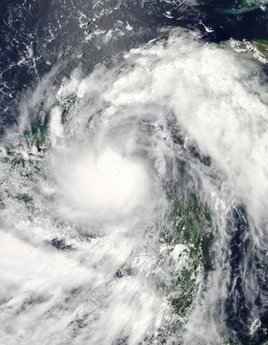Science and Health
Hurricane watch for Mexico, US as Alex strengthens
(Agencies)
Updated: 2010-06-29 11:37
 |
Large Medium Small |
VILLAHERMOSA, Mexico - Hurricane watches were posted Monday for a stretch of Gulf coast in southern Texas and northern Mexico as Tropical Storm Alex gained strength and appeared on track to become a hurricane before it makes landfall later this week.
| ||||
Alex was swirling through the Gulf of Mexico with winds of near 60 mph (95 kph) Monday afternoon on a path that would take it very near the Mexico-US border sometime Thursday, said the US National Hurricane Center in Miami, Florida. The storm is expected to become a hurricane Tuesday, and could build winds as high as 120 mph (193 kph) by Wednesday.
Conditions late Monday afternoon led the center to believe the storm will be less powerful than previously predicted but still likely to gain hurricane strength, forecaster Todd Kimberlain said.
Tropical storm-force winds extended up to 70 miles (110 kilometers) from the storm's center, and Alex was moving slowly to the north-northwest.
Heavy rains in Mexico's southern Gulf coast state of Tabasco forced the evacuation of about 300 families from communities near the Usumacinta river.
The hurricane watches extended about 225 miles (360 kilometers) south of the US border over an area of sparsely populated Mexican coast, and about 100 miles (160 kilometers) north along the largely unpopulated Texas coast from the Rio Grande to Baffin Bay.
|
 This June 26, 2010 NASA Aqua satellite image shows Tropical Storm Alex hovering over Guatemala, Belize, and Honduras. [Agencies] |
The tropical storm's center wasn't expected to approach the area of the oil spill off Louisiana's coast, said Stacy Stewart, senior hurricane specialist at the National Hurricane Center. But Alex's outer wind field could push oil from the spill farther inland and hinder operations in the area, Stewart said early Monday.
Alex caused flooding and mudslides that left at least five people dead in Central America over the weekend, though Belize and Mexico's Yucatan Peninsula appeared largely unscathed.
It made landfall in Belize on Saturday night as a tropical storm and weakened into a depression on Sunday as it crossed the Yucatan Peninsula.
Mexico's northern Gulf coast braced for heavy rains, and forecasters said precipitation from Alex would keep falling on southern Mexico and Guatemala until Tuesday, raising the possibility of life-threatening floods and mudslides.
"It is a fact we are going to get very heavy rains," said Gov. Fidel Herrera of the Gulf coast state of Veracruz.
On Sunday, heavy rains prompted a landslide in northwestern Guatemala that dislodged a large rock outcropping, killing two men who had taken shelter from the storm underneath, according to the national disaster-response agency.
In El Salvador, Civil Protection chief Jorge Melendez said three people were swept away by rivers that jumped their banks. About 500 people were evacuated from their homes.
There were no immediate reports of damage to Mexico's resort-studded Caribbean coast.
When Alex became the first named storm of the Atlantic hurricane season, officials immediately worried what effect it could have on efforts to contain the millions of gallons of crude spewing into the northeastern part of the Gulf.
A cap has been placed over the blown-out undersea well, directing some of the oil to a surface ship where it is being collected or burned. Other ships are drilling two relief wells, projected to be done by August, which are considered the best hope to stop the leak.
Alex was centered about 410 miles (660 kilometers) east-southeast of Tampico, Mexico, and 520 miles (835 kms) southeast of Brownsville, Texas, on Monday afternoon. Its rains could reach Veracruz and the border state of Tamaulipas late Tuesday or Wednesday, the Hurricane Center said.

